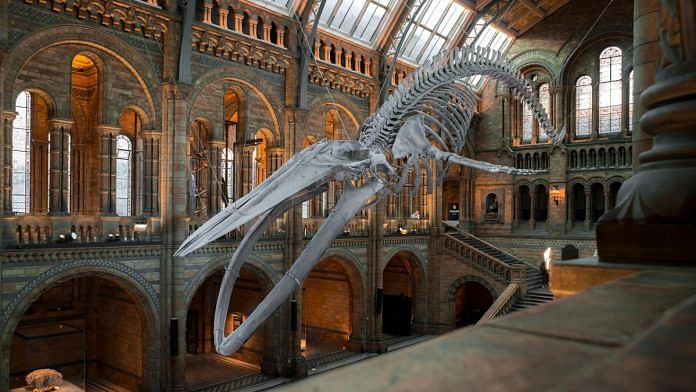New Delhi: Scientists have discovered the oldest ever human tools made from whale bones, in the Bay of Biscay in Spain. These tools, according to spectrometry conducted by researchers from Spain, France, and Canada, originated from the bones of five different species of great whales.
The findings were published in the journal Nature Communications on 27 May.
Whales are one of the oldest and largest mammals in our world, and have been used for many purposes by humans over the years–their fins and bodies for meat, their oil for cooking and other purposes, and some body parts even used for weaving and basket-making.
However, it is difficult for scientists and archaeologists to identify when exactly human-whale interactions begin since marine history and especially coastal archaeological sites are susceptible to damage due to rising sea levels.
In this one cave in Spain, archaeologists could find bones and worked bone tools made from bones of sperm whales, fin whales, blue whales, as well as grey whales. Not only does it shed light on the history of human-whale interactions, but it also says a little about what kinds of whale species were present in the region in that period of history. Read more here.
Sodium-fuelled flight might be the future
There’s interesting new research by MIT scientists who have developed a new kind of fuel cell that uses sodium and air to create energy. This potentially clean new source of energy goes beyond even lithium, which is the current choice for batteries for electric transportation.
There’s something even more interesting about this sodium cell, though–it can hold enough energy to fuel domestic flights.
The path-breaking findings were published in the journal Cell on 27 May.
The biggest hurdle for domestic flights is that the amount of energy stored in a battery directly corresponds to its weight; and the kind of energy needed for powering a flight would be just too much for normal lithium batteries to hold. However, this new sodium-oxygen fuel cell carries 3x the energy of a lithium-ion battery, potentially posing as a more efficient alternative for normal batteries.
This cell works on the principle of an electrochemical reaction between liquid sodium metal and oxygen, and is a refillable cell. While it is still in a prototype stage, researchers envision it as a game changer in the field of electric vehicles, including aviation, bringing in a new era of greener, cleaner transportation. Read more here.
Clearest ever pictures of Sun’s corona
An article published in the Nature Astronomy journal on 27 May covers a brand new development that could allow us to see the Sun like never before.
The outermost layer of the Sun is known as the corona, and for years, scientists have wondered why it is a million times hotter than the surface of the Sun. However, forget getting close to study it, we haven’t even been able to see the Sun clearly because of something called atmospheric turbulence.
Even our strongest microscopes have failed to clearly capture the Sun’s corona as anything more than a blur.
But with this new coronal adaptive optics created by the US National Solar Observatory, we have been able to overcome atmospheric turbulence to capture the clearest ever images of the Sun’s corona. The scientists witnessed for the first time ever that plumes of plasma—the hot gas that makes up the Sun—form and collapse in the corona, as well as how plasma raindrops fall onto the Sun.
These insights could ideally help astrophysicists uncover the reason behind the corona’s extremely hot temperatures as opposed to the rest of the Sun, bringing us closer to solving that big cosmic mystery. Read more here.
Bed bugs are humans’ oldest pests
A new paper published in the journal Biology Letters on 28 May suggests bed bugs are the oldest urban pests for humans, having followed a similar population trajectory as humans for the last 60,000 years.
Scientists from Virginia Tech in the US have traced the lineage of different species of bed bugs, which are parasitic insects that feed on human and mammal blood.
By tracing the population history of different bed bugs associated with different mammals like humans and bats, the scientists discovered how the particular strain associated with humans had the same demographic changes like humans did—its number declined during the last Ice Age 20,000 years ago, rose afterwards and saw expansions as and when humans moved to cities, establishing civilisations like Mesopotamia.
The genome sequencing of this strain of bed bugs provides a complete population history, and describes them as the first pests associated with humans, long before cockroaches or rats. Read more here.
(Edited by Amrtansh Arora)






